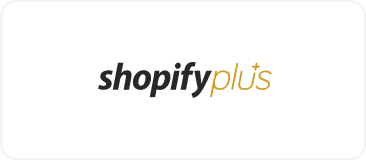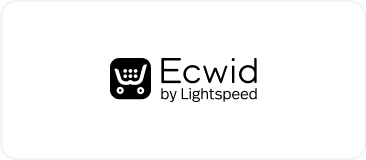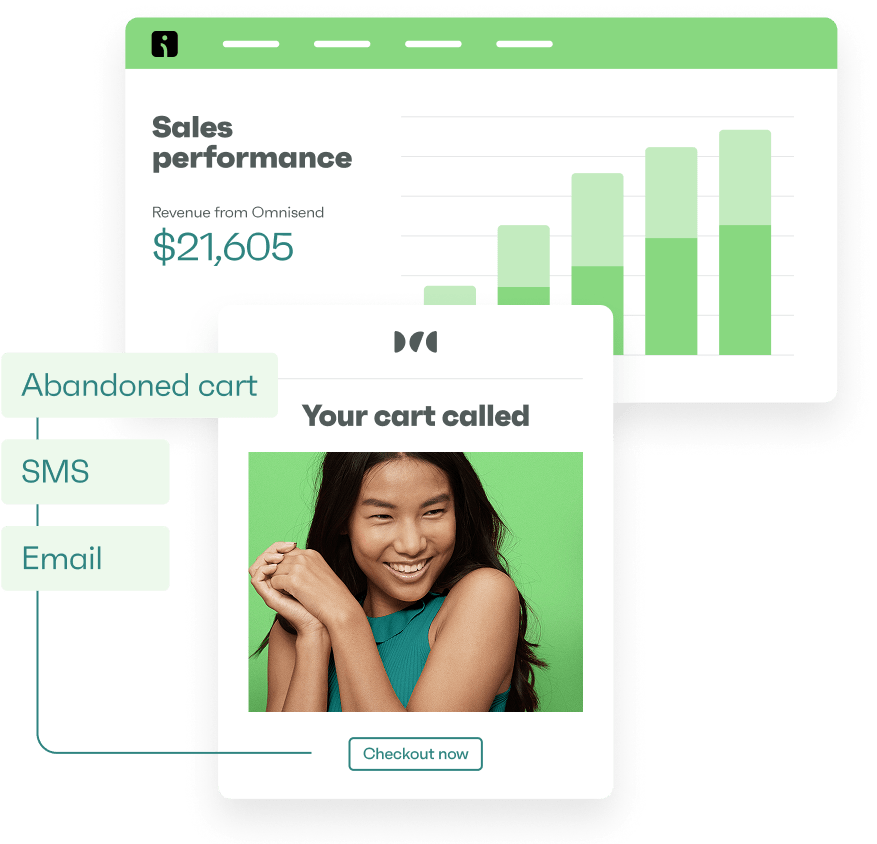
Drive sales on autopilot with ecommerce-focused features
See FeaturesShopify popups are essential for converting browsers into buyers. You can use either native tools or apps to create popups that capture emails, promote sales, and reduce cart abandonment — plus, you can add them to your store for free.
Appropriate popup targeting turns these interruptions into helpful moments. Show welcome discounts to new visitors, shipping offers at checkout, or win-back deals to past customers to make them feel like natural extensions of your shopping experience.
Join us below to master popup creation, targeting, and optimization for your Shopify store.
Quick sign up | No credit card required
3 methods to add Shopify popups
Want popups on your Shopify store? You’ve got three routes — apps that handle everything, Shopify’s built-in tool, or writing code yourself:
1. Third-party popup apps
To add a Shopify popup, head to the Shopify App Store and you’ll find Omnisend, Privy, OptiMonk, Justuno, Poptin, Wisepops, and about 50 other apps competing for your attention.
Most work the same way — install, pick a template, customize colors to match your brand, and publish. The fundamental differences show in triggers and targeting.
Exit-intent catches abandoning visitors, scroll percentage waits until they’re engaged, and time delays prevent annoying immediate popups. Better apps segment by location, device, or past purchases — showing different offers to first-time visitors versus returning customers.
Expect to pay $20–100 monthly for decent features. Free versions exist, but limit impressions or add watermarks.
Pros
- Professional designs and templates ready to use
- Advanced targeting and trigger options
- Built-in analytics and A/B testing
- No coding knowledge required
Cons
- Monthly subscription fees add up
- Another third-party service to manage
- Limited customization within app constraints
2. Shopify Forms app
Shopify quietly launched Forms as its answer to popup apps. You can find it in your admin under Marketing > Shopify Forms. No installation needed — it’s already there.
The templates cover basics — email signups, discount codes, and age verification. Pick one, adjust the text, and change button colors. That’s about it for customization. Your captured emails flow straight into Shopify’s customer list and are ready for email campaigns.
Missing features become obvious fast. No exit popups, no A/B tests, no “show after scrolling 50%” options. But zero cost and zero setup complexity make it perfect for testing whether popups work for your store.
Pros
- Completely free with Shopify
- Direct integration with Shopify
- Simple setup in minutes
- No external accounts needed
Cons
- Basic templates only
- No advanced triggers or targeting
- Limited design customization
- No performance analytics
3. Custom code implementation
Open your theme editor, create a new snippet called popup.liquid, and start coding. You control every pixel, every animation, every condition for display.
JavaScript handles the logic — localStorage tracks if someone already saw your Shopify email popup, setTimeout controls delays, and event listeners watch for exit intent.
CSS positions everything and adds transitions. Liquid pulls in dynamic content like product names or customer tags.
The learning curve is significant if you’re not already comfortable with code. One misplaced bracket breaks your entire store. Plus, you’re debugging across browsers, fixing mobile layouts, and updating everything when Shopify changes its architecture.
But you’ll never pay app fees or hit feature walls. Your popup does what you program it to do.
Pros
- Complete control over design and functionality
- No recurring fees
- Integrate with any system
- Build unique features that apps don’t offer
Cons
- Requires coding knowledge
- Time-intensive to build and maintain
- You handle all debugging
- Risk of breaking your store
Method 1: Adding popups with Omnisend
Omnisend’s form builder creates popups, embedded forms, flyouts, and landing pages from the same interface. You’ll find templates for email collection, SMS capture, cart abandonment prevention, and product recommendations.
Popular popup types include:
- Wheel of Fortune gamified popups — Visitors spin for discounts and are rewarded for participation, such as in this example:
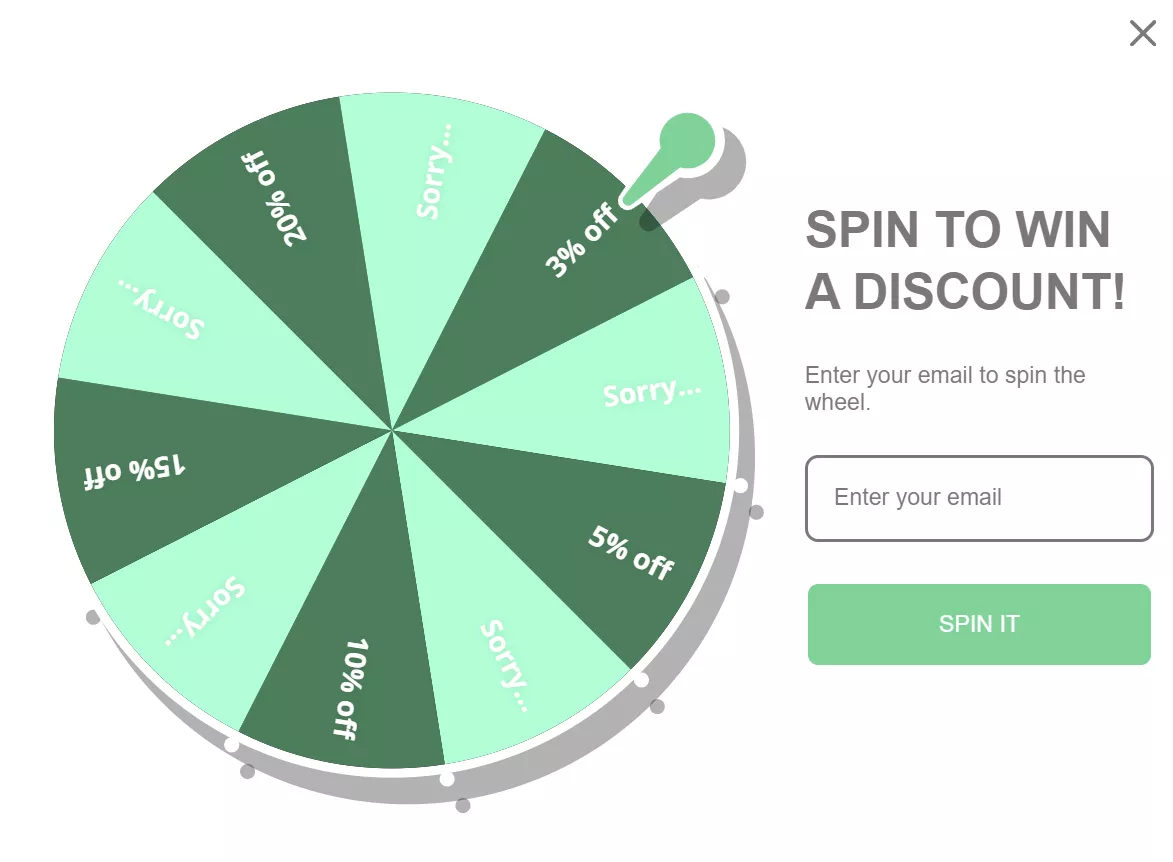
- Multi-step forms — Ask “Save on your purchase” first, then collect emails after the micro-yes, like this:
Step 1
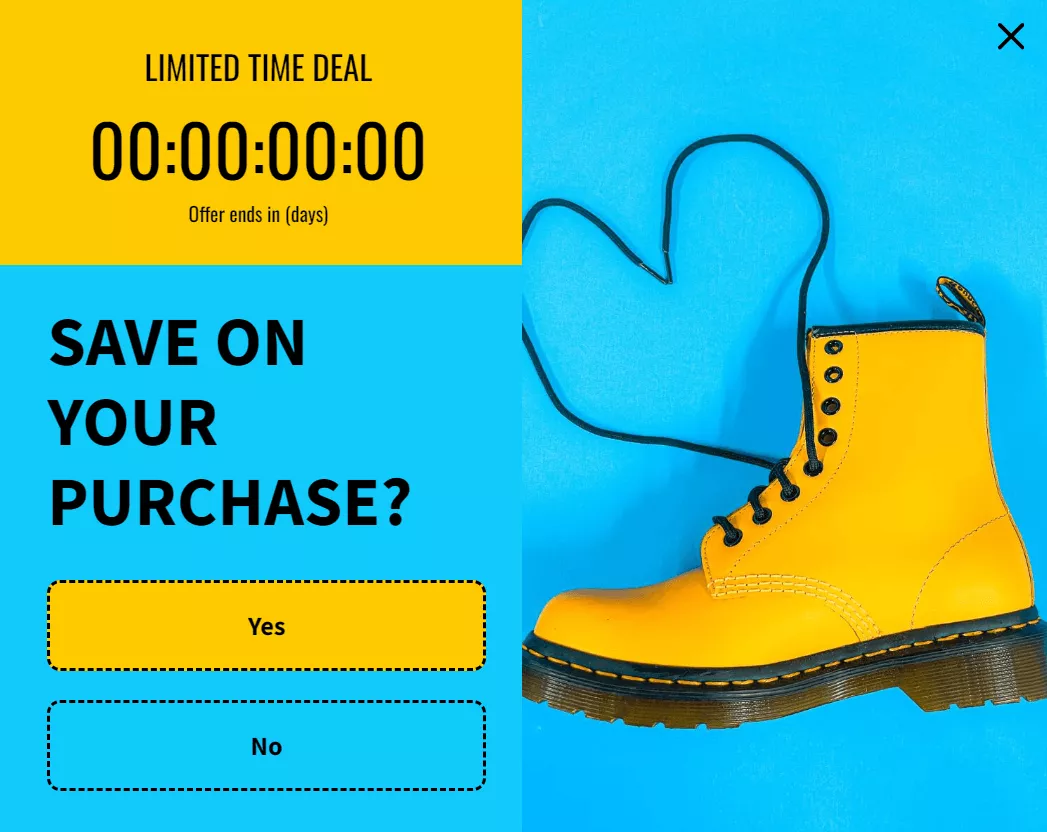
Step 2
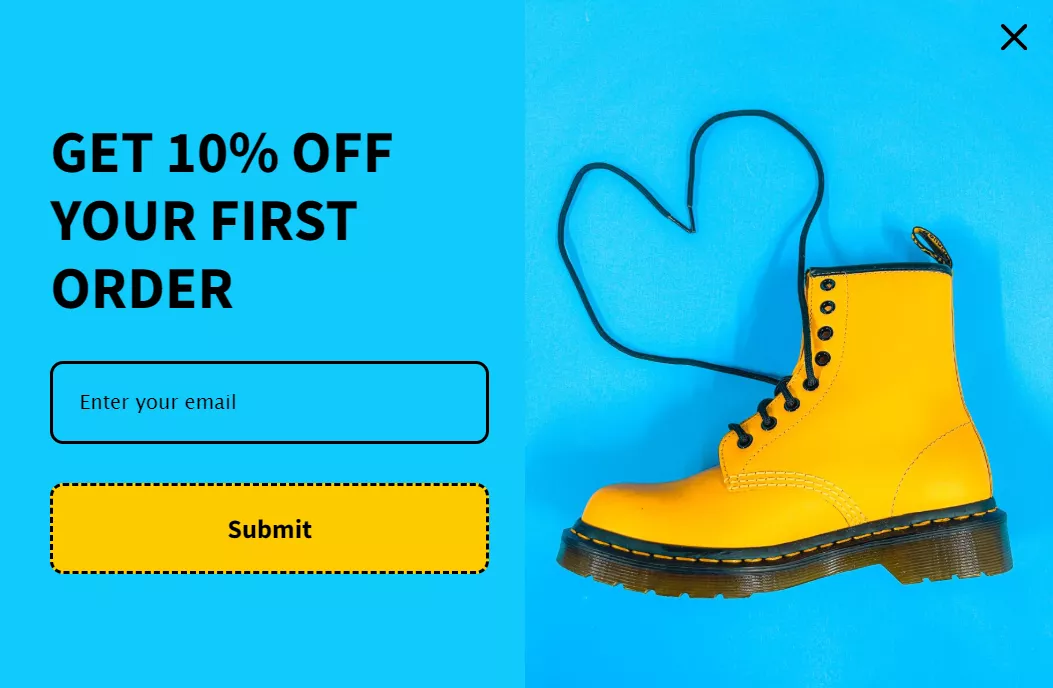
- Teaser forms — Subtle tabs at screen edges that expand when clicked
- Birthday collectors — Gather dates for automated gift campaigns year-round
- Preference surveys — Quick questions like “Shop men’s or women’s?” for instant segmentation
Triggering options range from exit-intent (tracking mouse movements toward close buttons) to scroll percentage and time delays. You control when popups appear — after 30 seconds browsing, halfway down product pages, or when carts hit $50.
Omnisend’s Shopify certification brings one-click installation and automatic discount code generation — no duplicate codes on coupon sites, no manual imports.
Form submissions flow directly into email workflows, triggering a welcome series based on which popup visitors completed.
Here’s how to add popups on Shopify with Omnisend:
Note: If you’d rather watch a video than read our tutorial, here’s our walkthrough guide:
1. Access the form builder
Navigate to Forms > Create form > Style > Popup in your Omnisend dashboard.
Pick a template from the Forms library — you’ll see options for Shopify newsletter popups for signups, promotional offers, gamification wheels, and seasonal designs:
Here’s a screenshot of Omnisend’s template library:
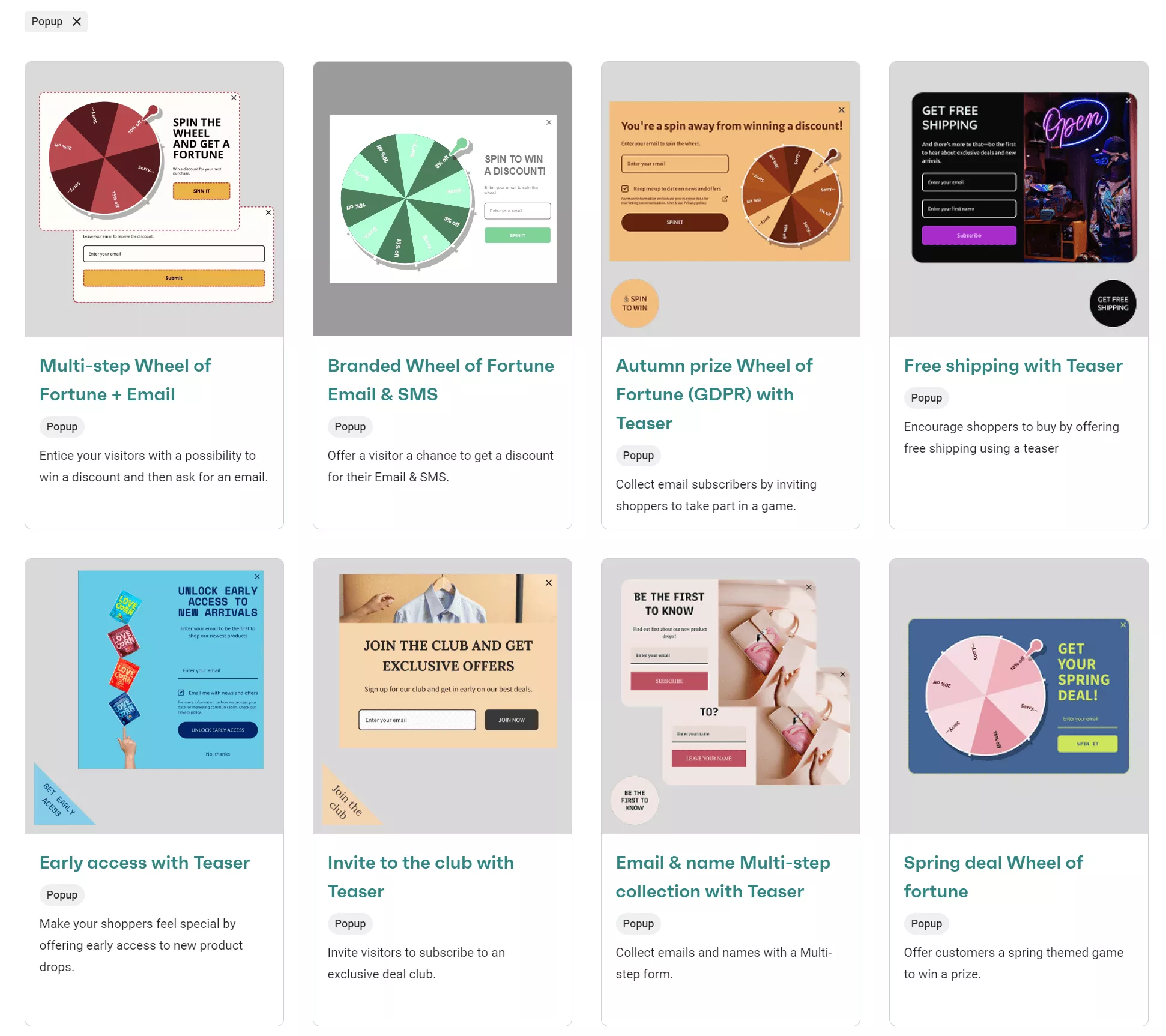
Clicking a template opens the Form Builder interface.
2. Customize the design layout
Click Theme settings to control your popup’s appearance. You can find Theme settings in the top right sidebar below the Enable form button:
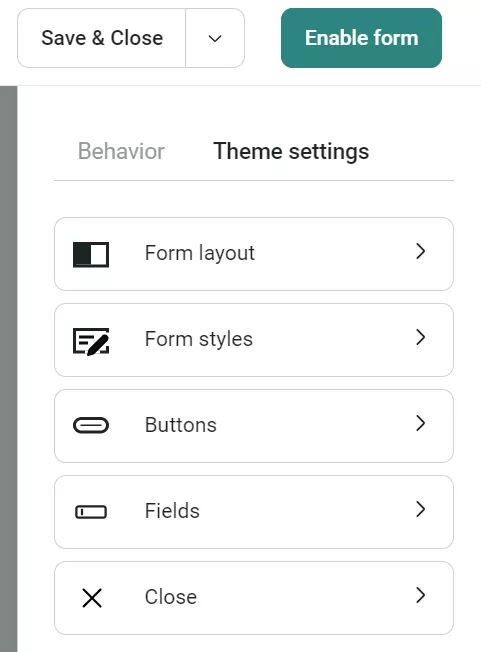
Under Form layout, set the form width (300–1000px default range), choose image placement (left, right, top, or background), and adjust padding.
The Fields section lets you customize input shapes, while Buttons controls global button styling — border styles, corner rounding, and colors.
3. Build your form content
Drag items from the left sidebar onto your form. Available blocks include:
- Email field — Add placeholder text, make required, customize error messages
- Phone field — Select default country, shows as flag + country code
- Legal block — Required for GDPR/TCPA compliance with privacy policy links
- Images — JPG, PNG, or GIF formats under 2000px dimensions
- Dropdown — Collect gender, country, or custom properties
Here’s an image showing all available Items:
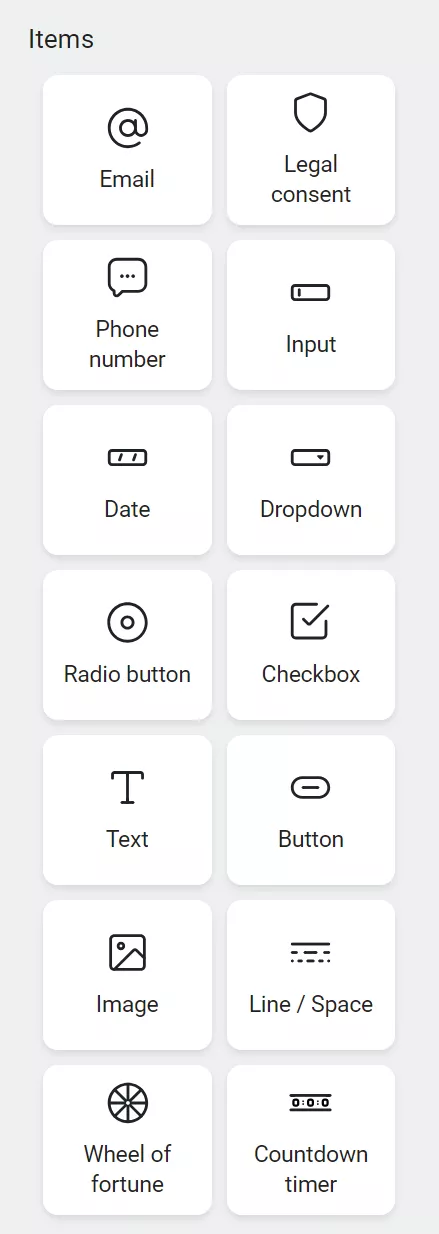
Click any block to access its settings — adjust text, styling, and field requirements.
4. Configure display triggers
Open the Behavior tab, located next to Theme settings, to set display rules:
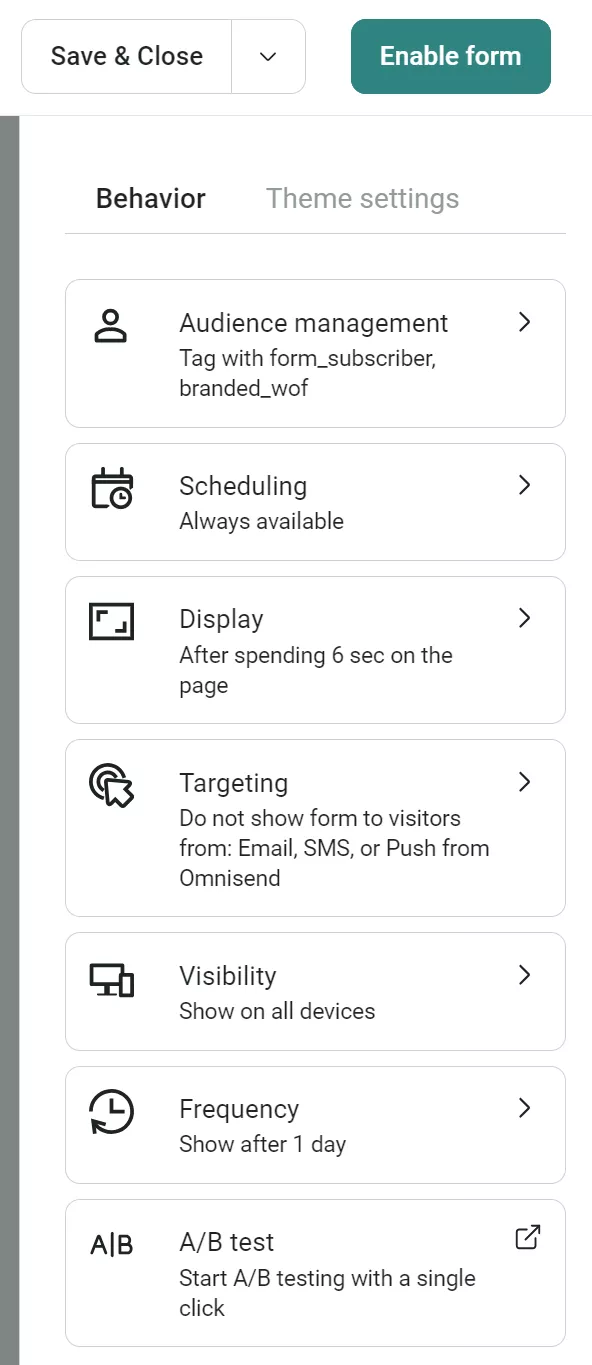
- Page visits — Set the number of pages viewed before the popup appears
- Time on page — Delay in seconds before showing
- Scroll depth — Percentage of page scrolled
- Exit intent — Triggers on rapid upward scrolling (works on all devices)
Multiple rules connect with OR logic — the popup shows when any single condition is met.
5. Target specific audiences
The Targeting section in the Behavior tab controls who sees your popup and where it appears:
Visitor targeting options:
- All visitors — Show to everyone
- Don’t show to existing contacts — Target new visitors only
- Show to existing contacts — Display exclusive offers to subscribers
- Target by specific segment — Include or exclude custom segments
Page targeting options:
- Appears on URL — Display on specific pages or UTM parameters
- Does not appear on URL — Exclude certain pages
- Appears on out-of-stock product pages — Special trigger for inventory
Note: Page targeting uses AND logic, meaning all URL conditions must match for the popup to display.
6. Set reappearance frequency
In Frequency settings, choose intervals:
- Seconds
- Minutes
- Hours
- Days
If disabled, the form always appears to visitors. Enable frequency limits to avoid overwhelming store visitors and reducing the quality of your user experience.
7. Create success messages
Click Success in the bottom menu. Edit the success message like the main form — add text, images, buttons, or promotional content. Here’s an example:
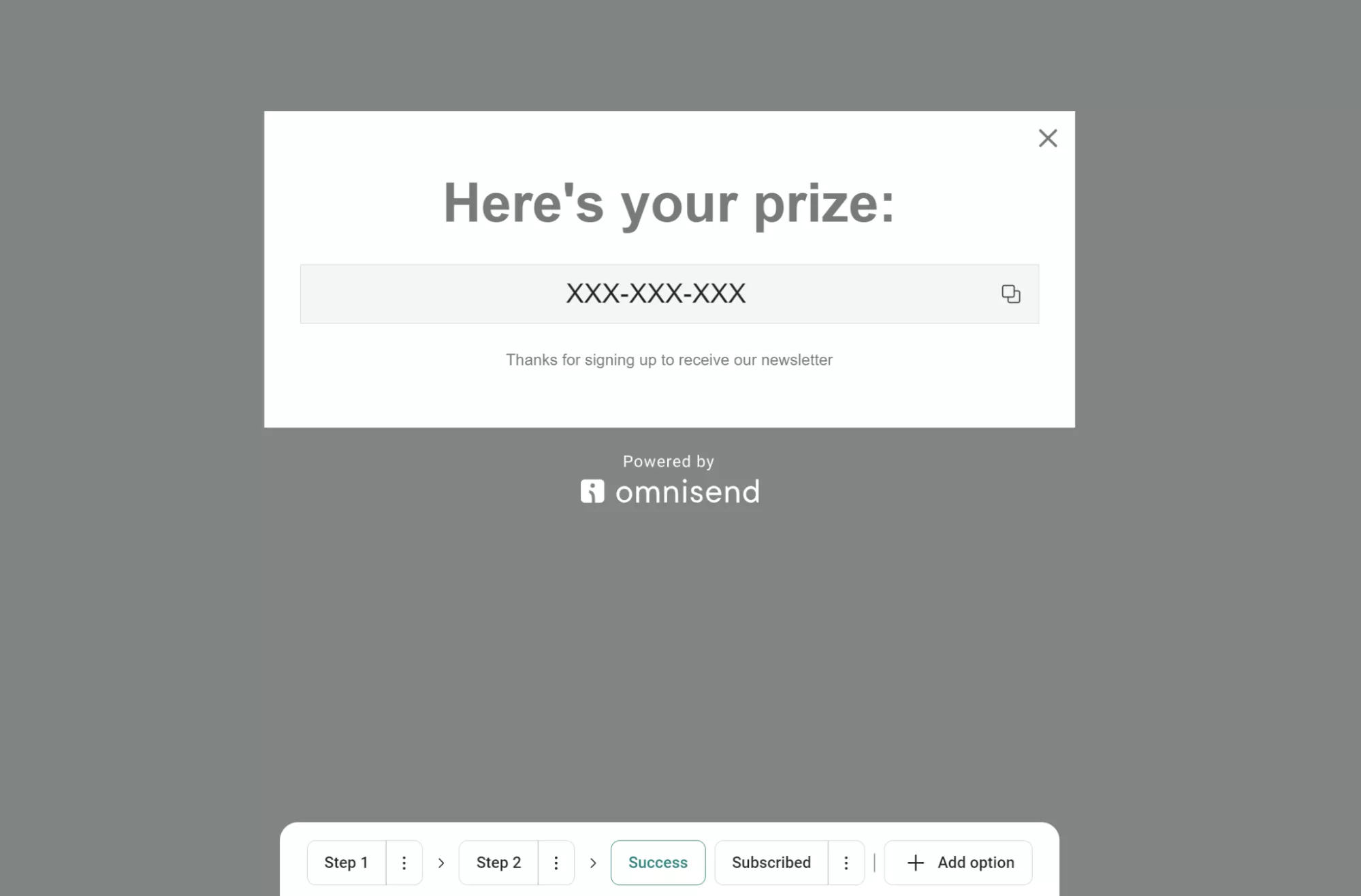
Use the Subscribed section to create a separate message for returning subscribers who are already on your list. For instance:
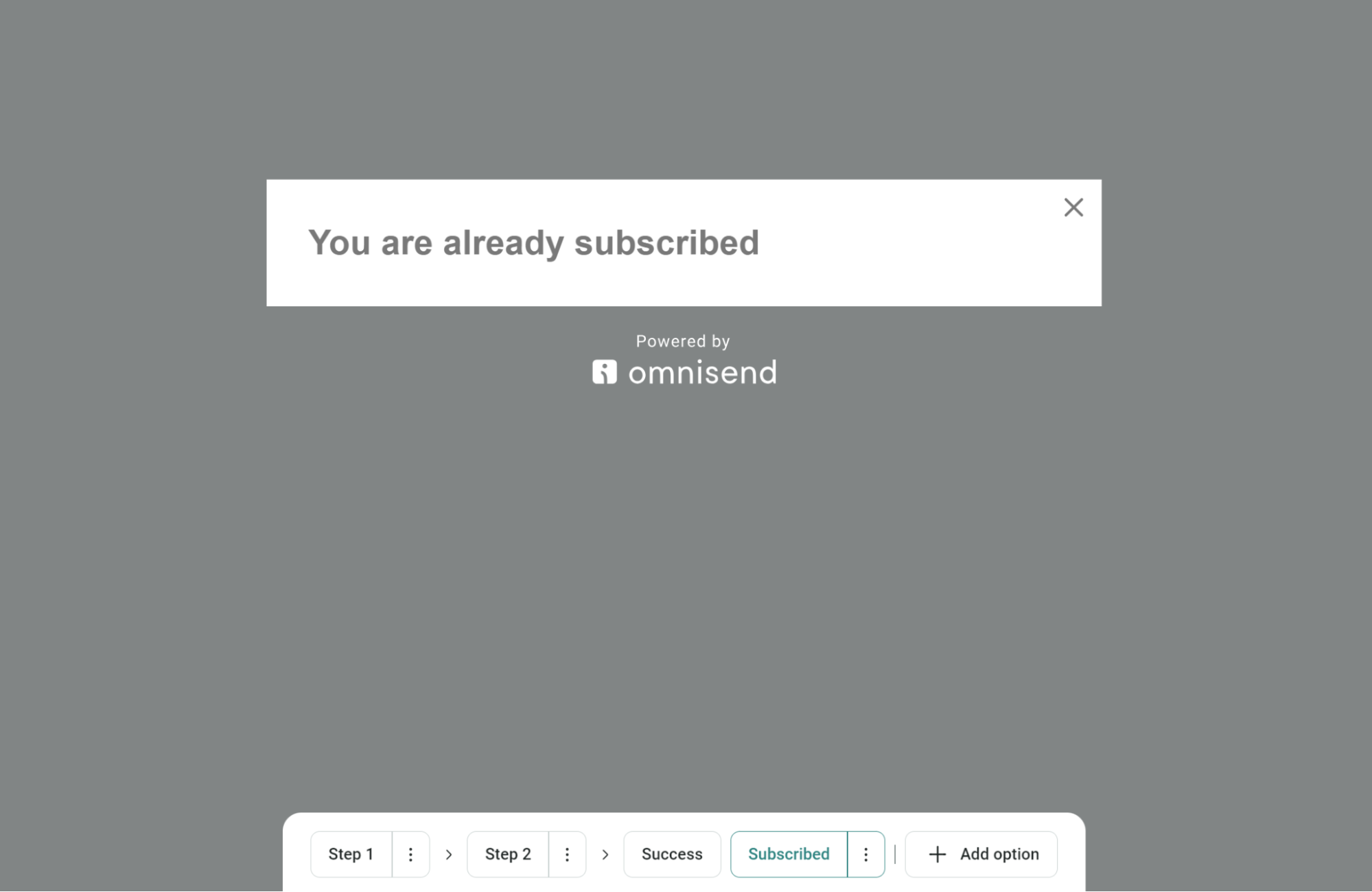
8. Enable A/B testing (optional)
Toggle A/B test in Behavior settings to experiment with different popup versions. Clicking A/B test will load this page:
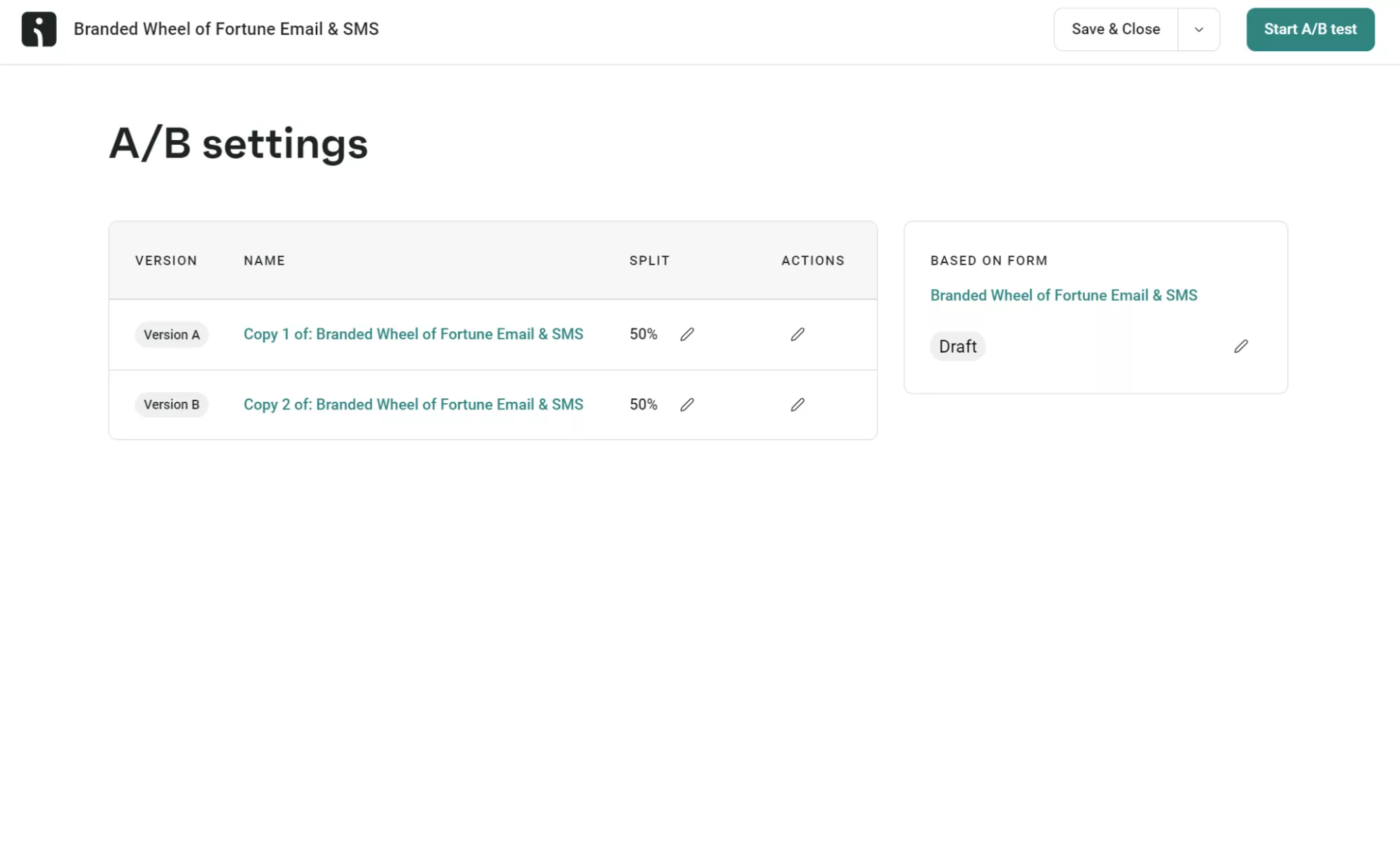
It’s best practice to test variations of content, timing, or design to optimize performance.
9. Preview and activate
Use Undo/Redo buttons (unlimited steps until page reload) to refine your design. Click Enable to make the popup live immediately or Save & Close to save as a draft — access saved forms through the Forms dashboard to monitor performance metrics:
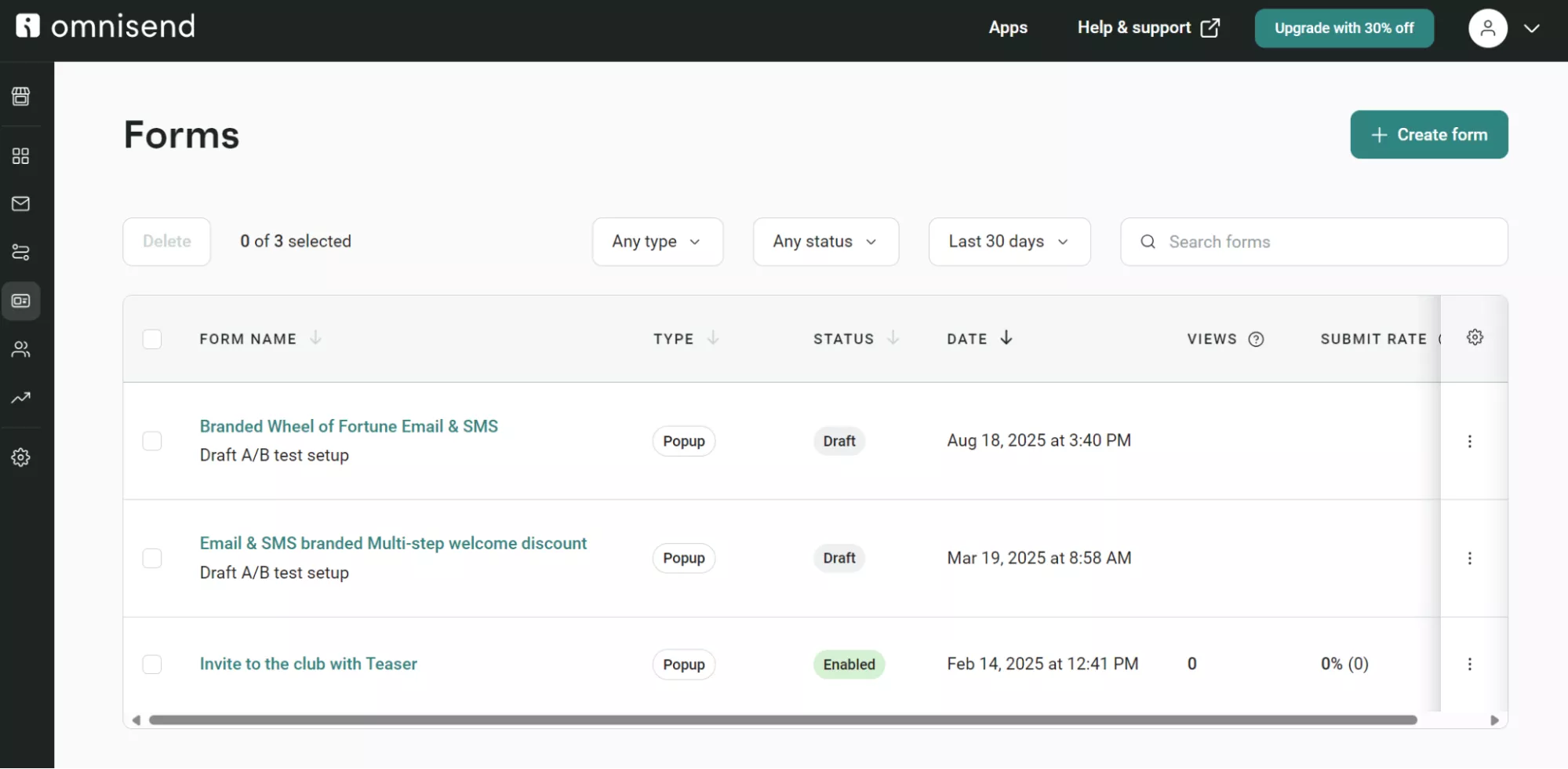
Pro tip
While these instructions show Omnisend’s interface, most Shopify popup apps follow the same workflow — install the app, browse templates, customize design in a visual editor, configure display rules, then publish.
The buttons and menu names change between apps like Privy or OptiMonk, but you’ll find similar template libraries, drag-and-drop builders, and behavior settings in each tool.
Method 2: Adding popups with Shopify’s native Forms app
Shopify offers built-in popup features via the Forms app and the Forms theme app embed. After adding these to your theme, you can create and enable popups.
The benefit of using Shopify Forms is that it’s completely free, with no external accounts or APIs necessary. Additionally, you don’t need to leave your Shopify admin panel to create popups.
Follow these step-by-step instructions to use Shopify’s native popups:
1. Install the Forms app and enable popup display
First, let’s access Shopify Forms:
- From your Shopify admin, go to Settings > Apps
- Click Forms to open the Forms dashboard:
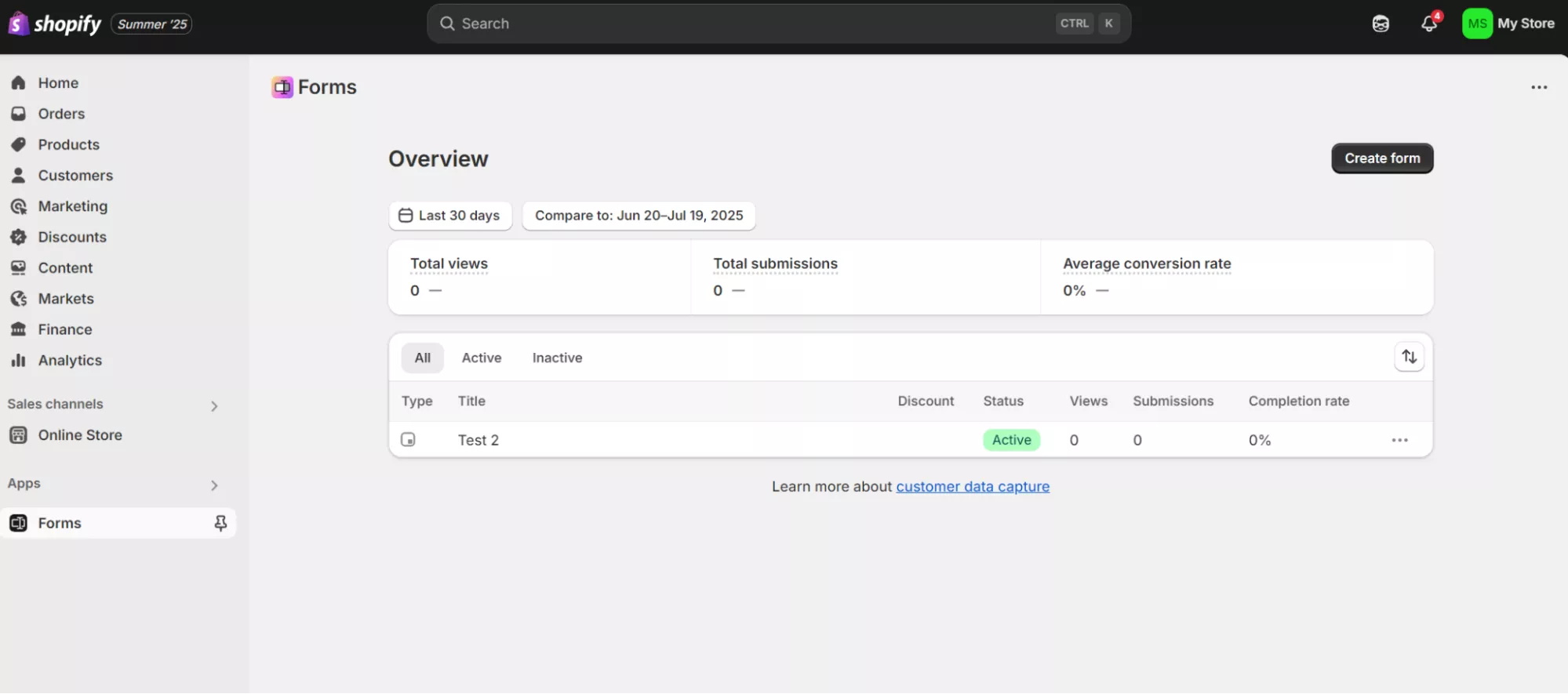
- Familiarize yourself with the Forms dashboard — it lists your forms, provides a status, and displays analytics, such as views and submissions
Next, enable popup display on your store:
- Navigate to Online Store > Themes:
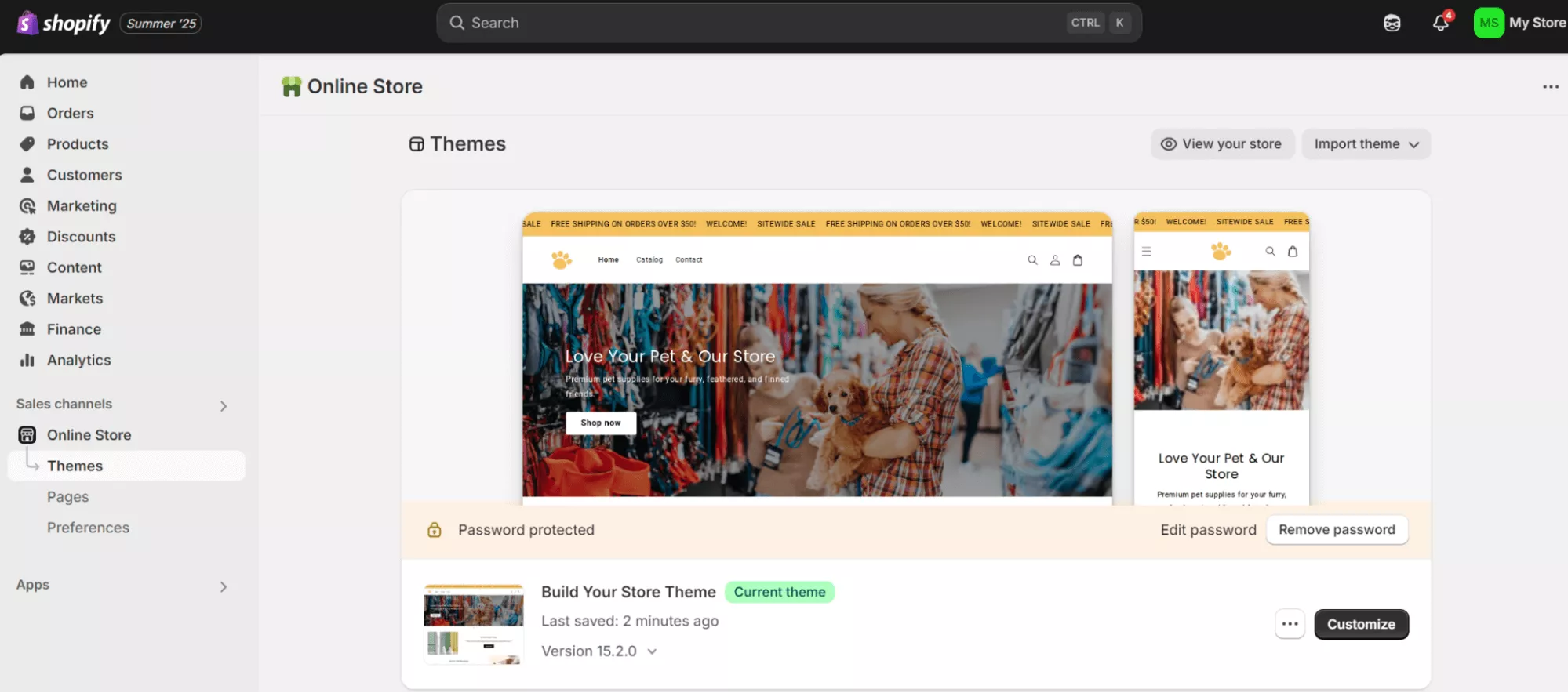
- Find your active theme and click Customize
- Click the App embeds icon in the theme editor sidebar:
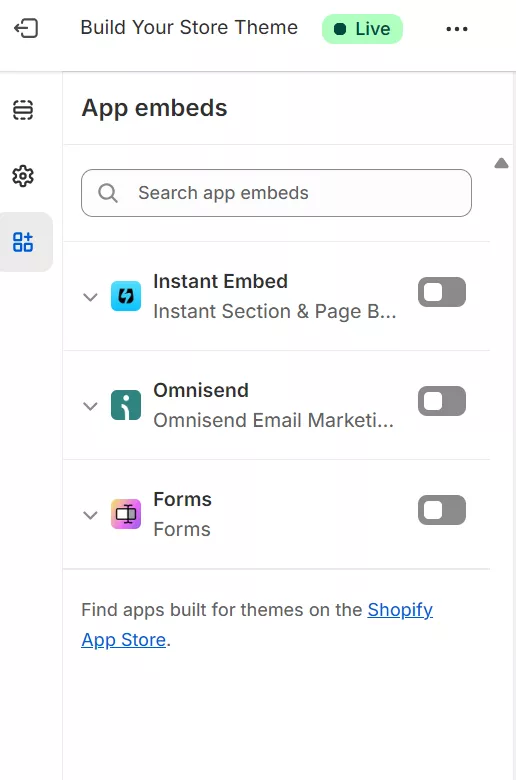
- Toggle Forms to activate it
- Click Save
Without activating the Forms theme app embed, your popups won’t display even after creation.
2. Create your popup form
From the Forms app:
- Click Create form
- Select Popup form (not Inline form):
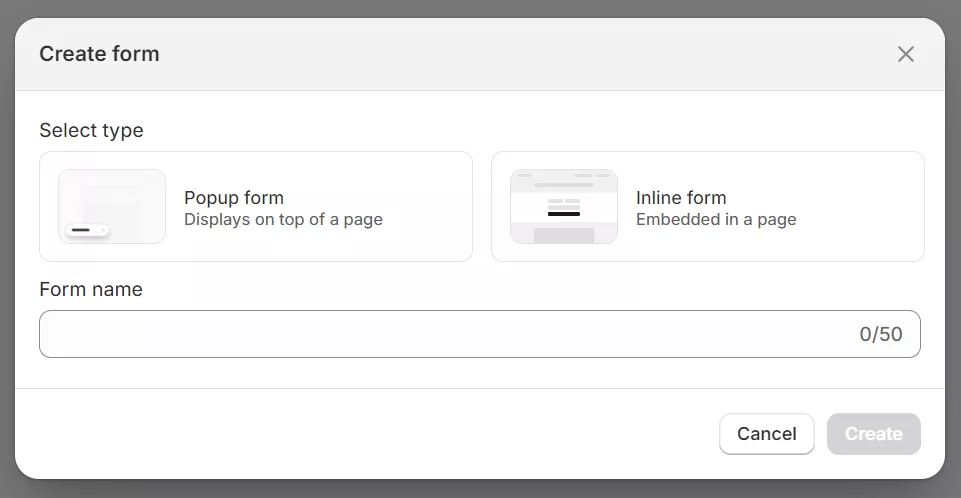
- Enter a form name (e.g., “Newsletter Signup” or “10% Off Welcome”)
- Click Create
Note: Your form opens in the editor with Active status by default — it will display immediately based on your settings.
3. Configure form display mode
You will now see this dashboard:
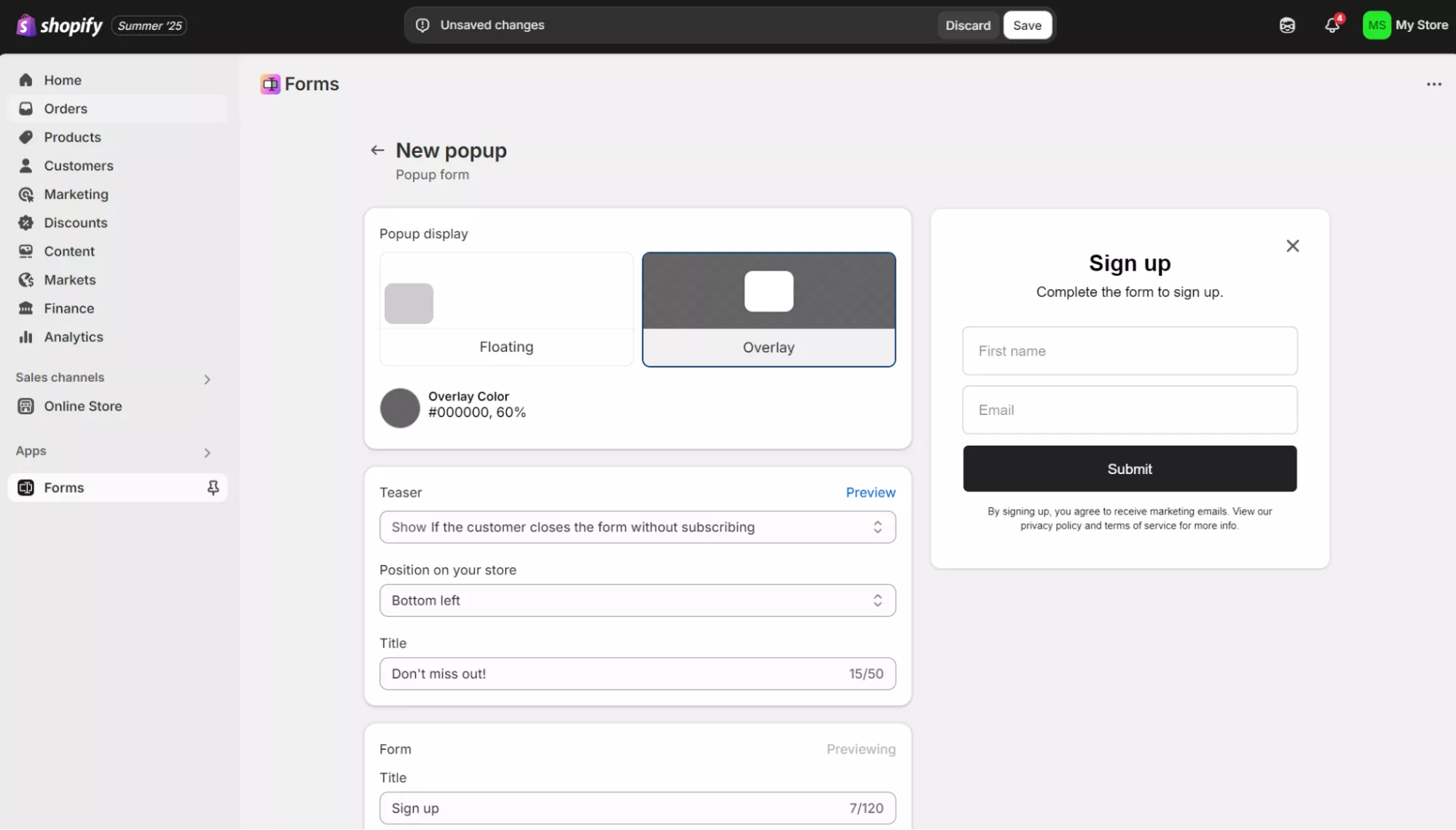
Choose between two display options:
- Floating — Form appears as a corner popup with an optional teaser
- Overlay — Form displays centered with a darkened background
For floating forms, select the position (bottom-left, bottom-right, etc.). Overlay forms always appear centered.
4. Design your popup appearance
The Styling box provides multiple settings for form customization, as shown below:
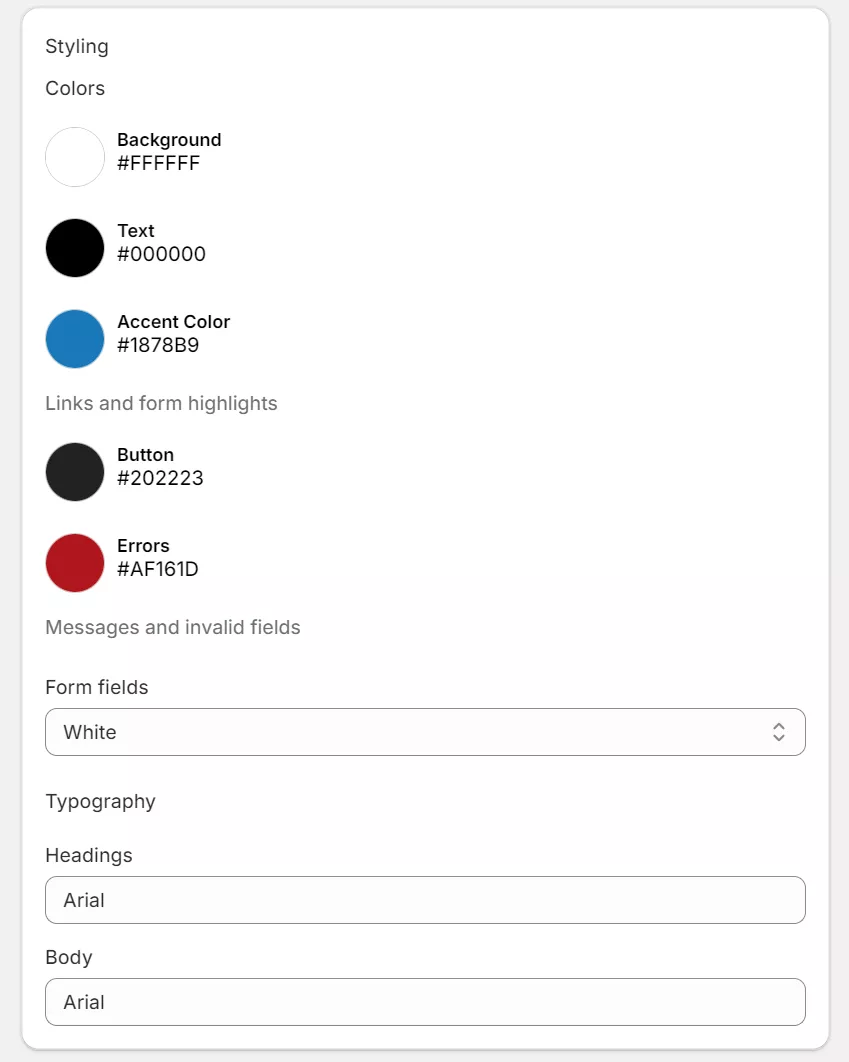
Additionally, you can edit your popup image and teaser.
Styling settings:
- Colors — Set background, text, field, button, and error message colors
- Form fields — Choose white or transparent backgrounds
- Typography — Select fonts for title and body text from available options
Image settings (optional):
- Background image — Full popup background with opacity control
- Image left/right — Side placement beside form fields
- Scale options — Control how images fit within the popup
Teaser settings (floating forms only):
- Show options — Display before form, after close, or never
- Position — Corner placement with optional rotation
- Title — Short text to attract clicks
5. Set display triggers and targeting
Shopify Forms lets you choose on which devices and pages to show your popup, plus set triggers to display on different page views:
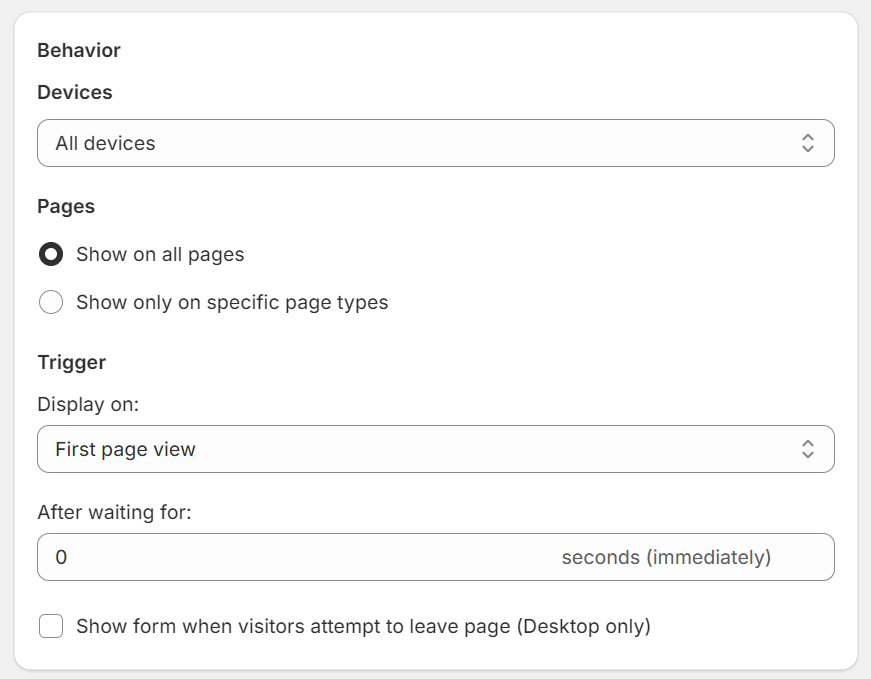
Trigger options:
- Page view count — Show on 1st, 2nd, or 3rd page view
- Time delay — Immediately or after specified seconds
- Exit intent — When the cursor moves toward the address bar (desktop only)
Visibility settings:
- Devices — All devices, desktop only, or mobile only
- Pages — All pages or specific types (product, collection, etc.)
Note: Shopify Forms cannot target specific URLs or exclude certain pages, like checkout.
6. Add form fields
Use the editor to customize fields:
- Email field (required by default)
- Additional fields like name, phone, or custom questions
- Privacy consent checkboxes for compliance
- Success message after submission
To create announcement popups without email collection, remove all form fields and add only text/images with a button.
7. Save and monitor
Click Save to activate your popup:

New forms are automatically set to Active status and begin displaying based on your configured rules. Monitor performance in the Forms app dashboard — you can view submission counts and manage multiple forms from one location.
Pro tip
While Shopify Forms handles basic popup needs, you’ll hit limitations quickly. No A/B testing means guessing what converts best. No behavioral targeting means showing the same offer to everyone.
If you need features like cart value triggers, customer segment targeting, or integration with SMS marketing, consider upgrading to a specialized app.
Method 3: Manual code addition
While Omnisend and Shopify Forms are the best ways to easily add popups to your store, you can do it manually with code.
This option is more advanced and requires coding knowledge. You should back up your theme files before making any edits or changes.
Use manual code when you need unique popup behaviors that apps can’t provide — custom animations, specific JavaScript triggers, integration with proprietary systems, or complete control over popup timing and styling.
Creating a popup form in HTML
HTML is the simplest way to add a custom popup to your Shopify store. The form below was created by us and tested with the W3Schools HTML tool:
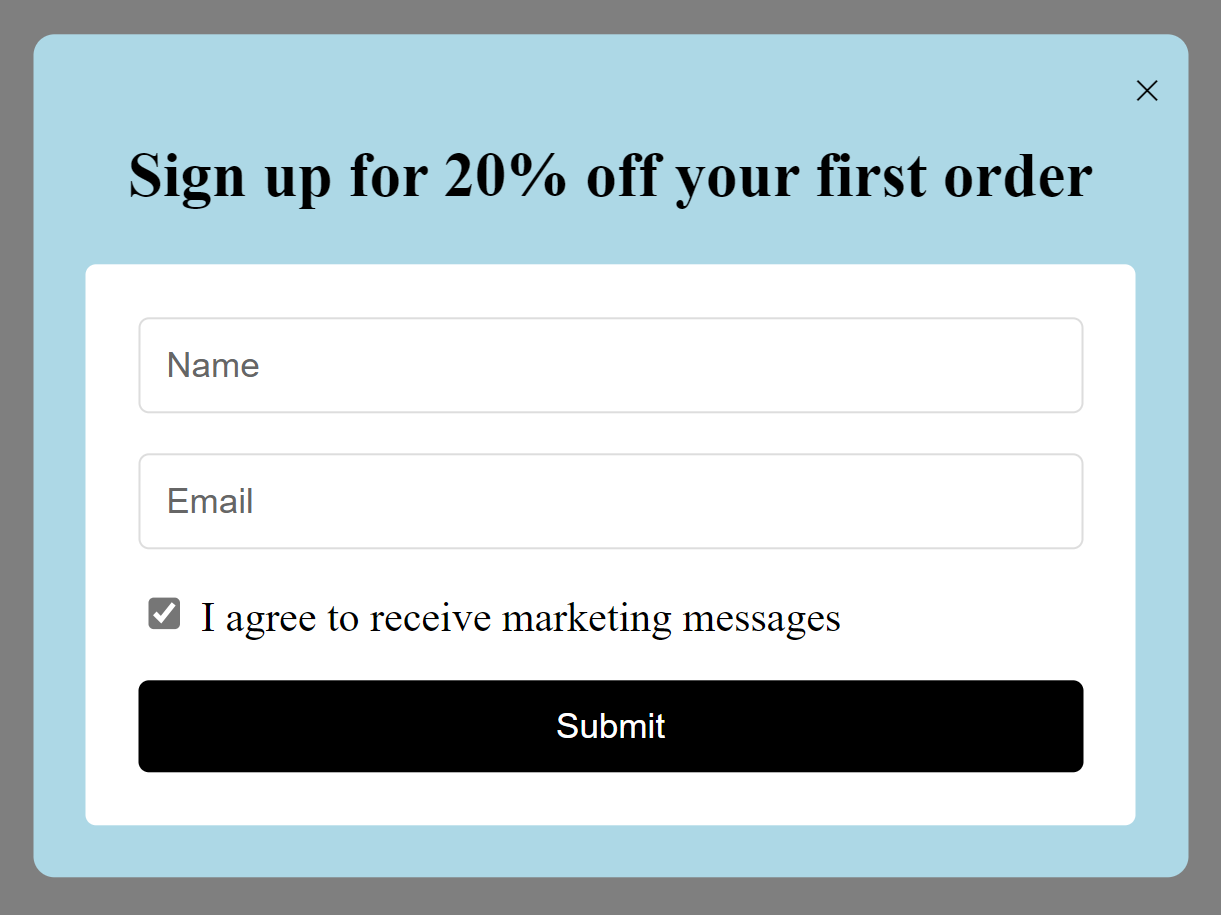
There’s a lot going on with this form to make it look the way it does. Here’s the code (feel free to grab it and reuse it):
| {% schema %} { “name”: “Custom Popup”, “settings”: [] } {% endschema %} <style> .popup-container { display: none; position: fixed; top: 0; left: 0; width: 100%; height: 100%; background-color: rgba(0, 0, 0, 0.5); z-index: 1000; } .popup { position: fixed; top: 50%; left: 50%; transform: translate(-50%, -50%); background-color: lightblue; padding: 20px; border-radius: 8px; max-width: 400px; width: 90%; } .popup h2 { text-align: center; margin-bottom: 20px; } .popup-form { background-color: white; padding: 20px; border-radius: 4px; } .close-btn { position: absolute; right: 10px; top: 10px; cursor: pointer; font-size: 20px; } .form-group { margin-bottom: 15px; position: relative; } .form-control { width: 100%; padding: 10px; border: 1px solid #ddd; border-radius: 4px; box-sizing: border-box; } .form-control::placeholder { color: #666; } .checkbox-group { margin: 15px 0; } .submit-btn { background-color: black; color: white; padding: 10px 20px; border: none; border-radius: 4px; cursor: pointer; width: 100%; } </style> <div class=”popup-container” id=”popupForm”> <div class=”popup”> <span class=”close-btn” onclick=”closePopup()”>×</span> <h2>Sign up for 20% off your first order</h2> <div class=”popup-form”> <form id=”discountForm”> <div class=”form-group”> <input type=”text” class=”form-control” id=”name” name=”name” placeholder=”Name” required> </div> <div class=”form-group”> <input type=”email” class=”form-control” id=”email” name=”email” placeholder=”Email” required> </div> <div class=”checkbox-group”> <label> <input type=”checkbox” name=”marketing” checked> I agree to receive marketing messages </label> </div> <button type=”submit” class=”submit-btn”>Submit</button> </form> </div> </div> </div> <script> |
Note: Adding a popup to your Shopify store with manual code works with any Shopify theme by editing the theme files. You should always test the code in a preview before publishing it live to ensure it functions as intended.
Adding the HTML popup to Shopify
Once you have your form, you can add it to Shopify with these steps:
- From your Shopify admin, navigate to Online Store
- Click on Themes
- Click Customize
- Click the three dots at the top of the editor and select Edit code
- Under the Sections directory, click Add a new section
- Name it custom-HTML
- Click Done
After adding this code:
- Go to your theme.liquid file
- Add this line where you want the popup to appear (typically just before the closing </body> tag): {% section ‘custom-HTML’ %}
- Click Save
You can then preview your store. Here’s how our form looks:
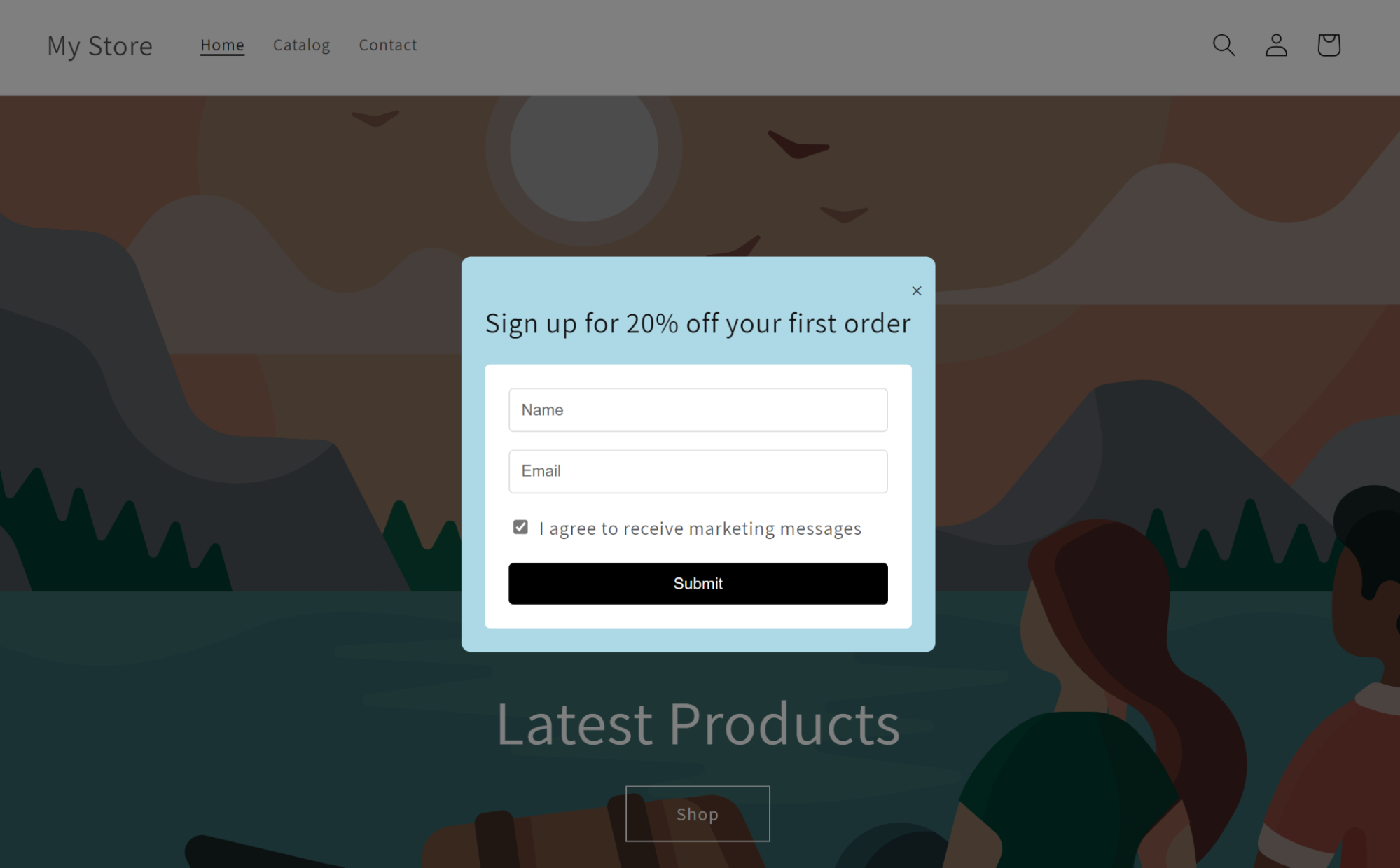
Customizing colors, form fields, buttons, content, opt-in boxes, and other elements requires tweaks to the code above.
For a functioning opt-in box in Shopify, you’ll need to connect it to the Shopify Customer Privacy API and potentially to your email marketing platform.
The API tracks consent with browser cookies, stores preferences (analytics, marketing, preferences) using setTrackingConsent() methods, and automatically blocks or allows Shopify pixels, audiences, and third-party scripts based on visitor choices and regional privacy laws.
Pro tip
Once you master manual code, creating custom popups becomes straightforward — you can replicate designs quickly, reuse JavaScript functions, and build exactly what you envision without app constraints.
However, popup apps remain more efficient for most stores. Tools like Omnisend handle mobile responsiveness, A/B testing, and analytics automatically — features that take hours to code manually.
Popular types of Shopify popups
Popups can serve different goals in your customer journey, such as increasing signups, promoting new products, and testing different offers.
Here are the most effective popup types for your Shopify store:
- Welcome popups — The classic “Hey, new here?” greeting with a 10–15% discount dangled in exchange for an email address
- Exit-intent popups — Last-ditch rescue missions for when cursors drift toward the X button, throwing out free shipping or bonus discounts
- Newsletter signup popups — No bribes here — “Join our list for insider access” appeals to brand loyalists who want your emails
- Spin-to-win gamified popups — Digital slot machines where everyone wins something, tapping into the same psychology that keeps people at casino wheels
- Cart abandonment popups — “Leaving so soon?” interventions that catch shoppers with one foot out the door, usually sweetened with shipping deals
- Upsell/cross-sell popups — “People also bought” suggestions that pop when carts hit certain thresholds or specific products land in the basket
- Countdown timer popups — Ticking clocks that manufacture urgency for flash sales, product drops, or “ending tonight” promotions
- Back-in-stock popups — Waitlist builders for sold-out items, turning FOMO into future sales when inventory returns
- Survey popups — One-click preference collectors asking “Shop men’s or women’s?” to segment visitors
- Announcement popups — Banner-style notices for shipping delays, holiday hours, new collection launches, or anything else that’s new
Pro tip
You should test popup formats and timing to see what gets the best engagement. For instance, a welcome popup for new visitors, exit-intent for browsers, and cart savers for almost-customers. Just space them out to avoid popup fatigue.
How to create a discount code popup on Shopify
Discount popups remain the most popular way for top Shopify stores to grow email lists — visitors trade their email for immediate savings. Here’s how to set up yours:
1. Generate your discount code in Shopify
Before building any popup, create the actual discount:
- Navigate to Discounts in your Shopify admin
- Click Create discount > Select discount type
- Enter a unique code, such as “FIRSTORDER” or “20OFF”:
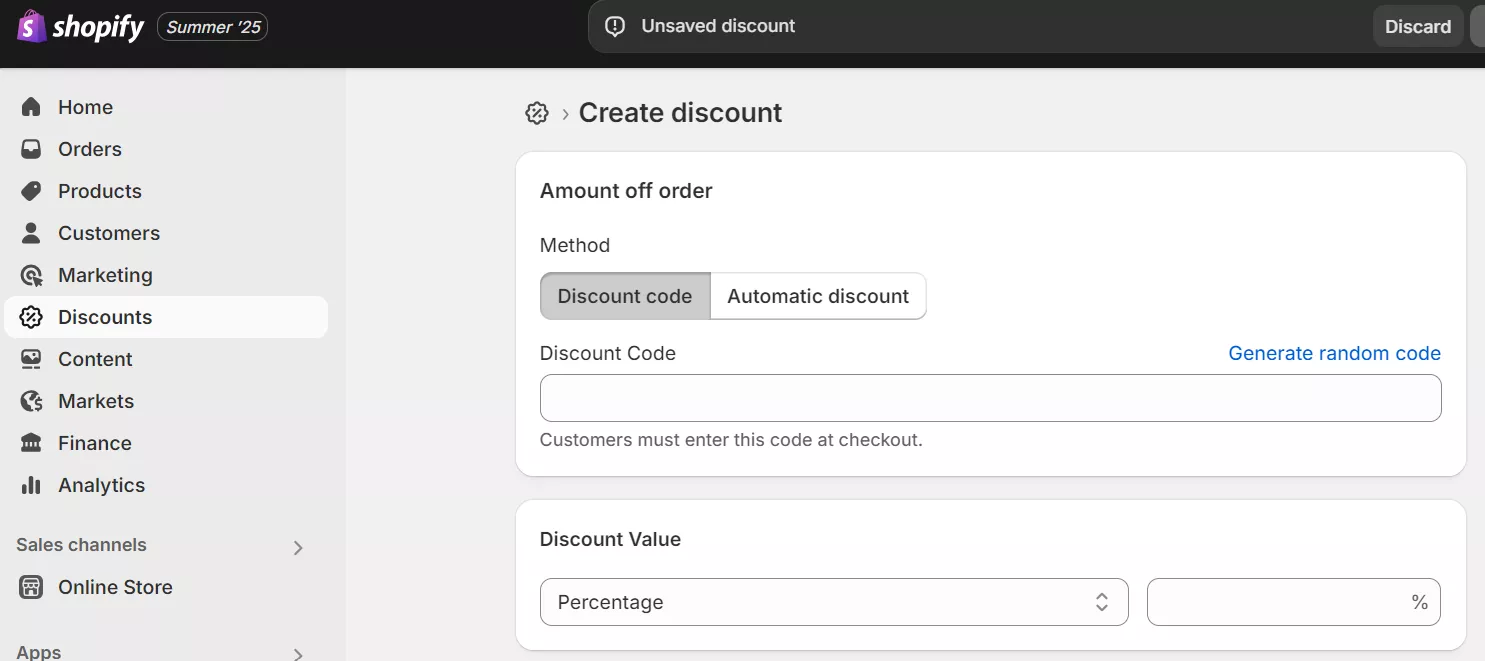
- Set the discount type (percentage or fixed amount)
- Choose Specific customers and select Customer gets discount for signing up
- Save the discount code
Keep this code handy — you’ll add it to your popup’s success message.
2. Build your discount popup
It’s best practice to create a discount popup that requests an email address, so that you can target customers with additional messages. However, you could also make a popup without any data capture fields if sales are your only goal.
The steps are similar:
Using Omnisend:
- Select a multi-step popup template from the popup library
- Edit the headline to specify the offer (“Get 10% off your first order”)
- Keep the form simple — just an email field and a subscribe button for the first step, and the discount code for the second step, or make the first step a yes or no, like this:
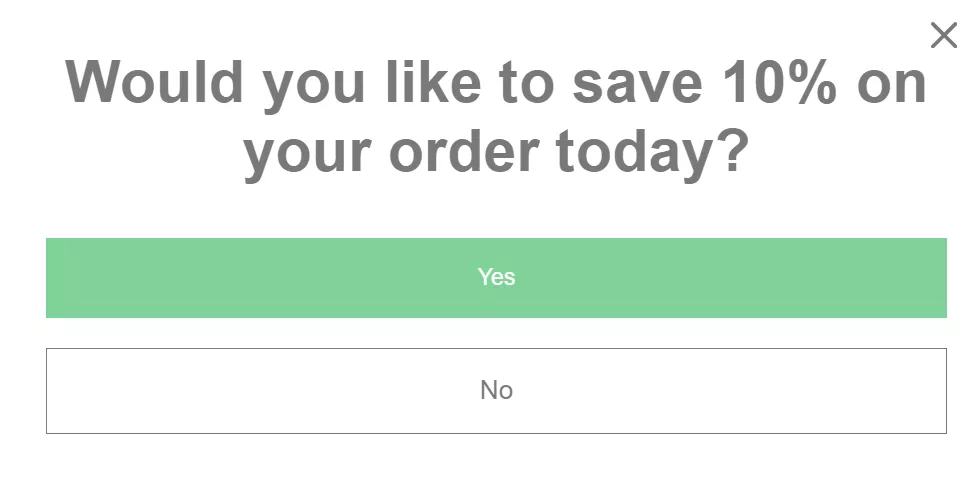
Using Shopify Forms:
- Create a new popup form
- Add headline text promising the discount
- Include only the email field to minimize friction
- Note: You’ll use one static code for all subscribers
3. Configure the success experience
Two ways to deliver the discount code:
Immediate display (recommended):
- Edit the success message to show: “Thanks! Use code WELCOME10 for 10% off”
- Add a “Shop Now” button linking to your collections
- Include copy-to-clipboard functionality if your app supports it
Email delivery:
- Set up an automated welcome email containing the code
- Adds an extra step but ensures subscribers check their inbox
- Better for building long-term engagement
4. Set display rules
Optimize when your discount popup appears:
- New visitors only — Exclude existing customers who already received discounts
- Time delay — Wait five to 10 seconds so visitors see your products first
- Exit intent — Catch abandoning visitors with the discount as a last resort
- Frequency cap — Show once per week to avoid annoying return visitors
5. Test before going live
Run through the whole experience:
- Visit your store in incognito mode
- Wait for the popup trigger
- Submit a test email address
- Verify the code displays correctly
- Test the discount at checkout
Pro tip
Omnisend can generate unique, single-use discount codes automatically, preventing code sharing on coupon sites. Shopify Forms requires manual code creation, meaning everyone gets the same code. If you intend for your Shopify popup form to be unique for everyone, then Omnisend is superior to Shopify Forms.
Targeting Shopify popups
Without targeting, you’ll show the same generic popup to everyone — returning customers see “new visitor” discounts, browsers get bombarded immediately, and conversion rates struggle to tick over a few percent.
Proper targeting creates relevant experiences that feel natural and pleasant for your customers. Additionally, you can test different segments (new vs. returning), timing (immediate vs. delayed), and contexts (homepage vs. product pages) to find what converts best.
In Omnisend, building a Shopify popup is just the first step. Your highest conversion rates will happen when you match popup content to visitor intent.
Here’s how to target your popups via Omnisend:
Target specific visitors
You can target specific visitors or sets of visitors with Omnisend’s popup targeting options. For example, you can choose to show the popup only to:
- Existing contacts
- New visitors and potential leads
Here’s an image showing all visitor targeting options:
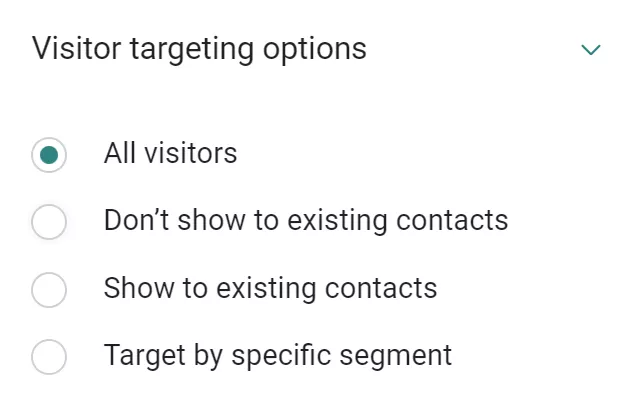
These allow you to provide exclusive offers and updates to loyal subscribers or target new visitors to grow your email list.
Target specific URLs
Omnisend lets you target popups to appear on certain URLs on your Shopify domain or similar URLs like Shopify collection pages. To do this, you must:
- Open your saved popup draft
- On the right side, you’ll find Targeting options under Behavior
- Define your targets under the Appears on URL or Does not appear on URL settings
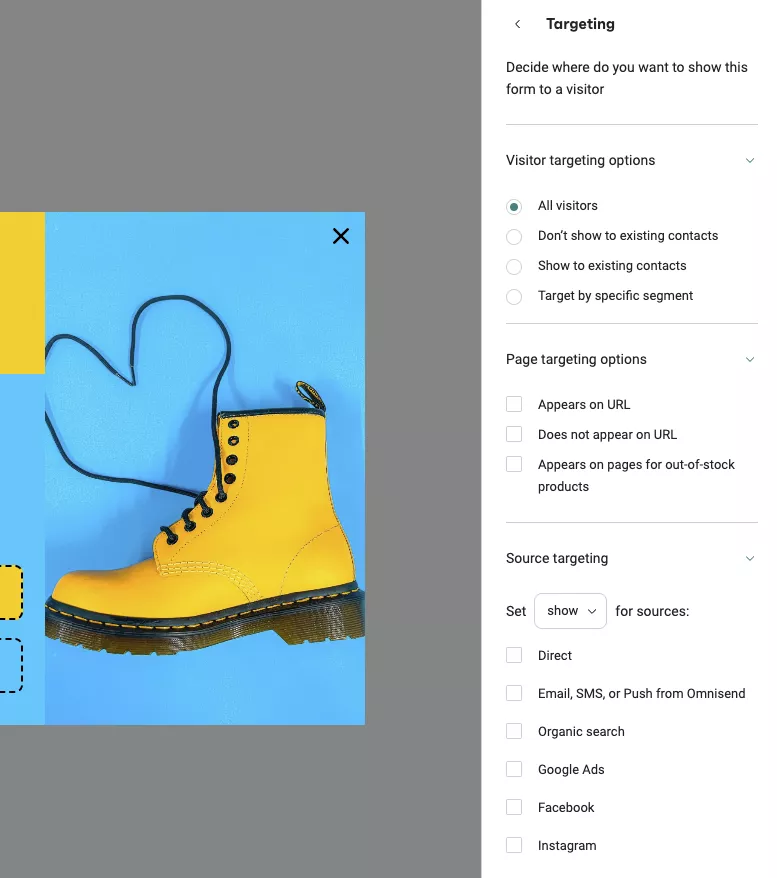
This ensures your popup content is relevant to the page visitors are on, thereby increasing engagement.
Target visitor behavior
You can also direct popups based on visitor behavior by navigating to Behavior > Display. Here are some of the options available to you:
- Time on page: Show the popup after a certain time delay or when the visitor is about to leave the page
- Scroll depth: Display the popup after the visitor has scrolled a certain percentage of the page
- Exit intent: Your popup will display when visitors are about to leave
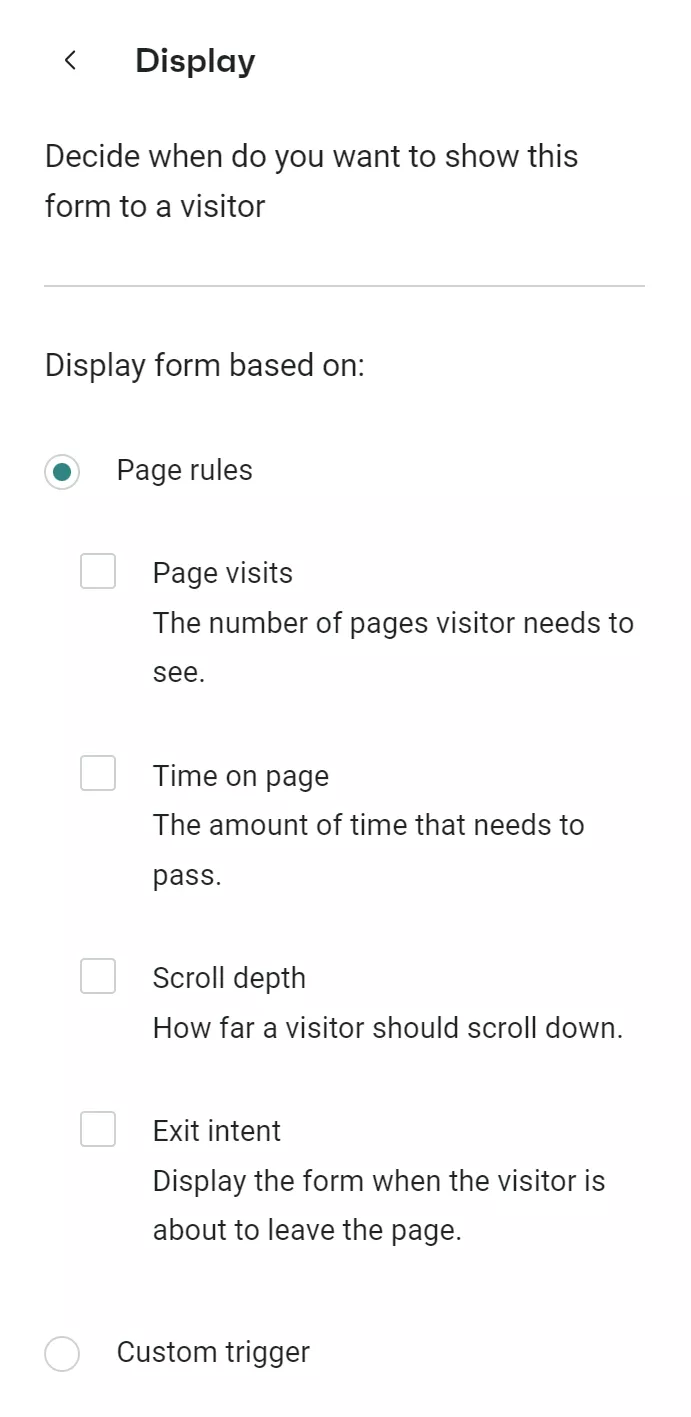
Geo-targeting Shopify popups
Omnisend lets you target popups by segment, so if you have segments that group customers by their location, your popups can show only for these customers. Here’s how:
- Navigate to Behavior > Targeting in your form builder
- Under Visitor targeting options, select Target by specific segment
- Use the checkboxes to select Include or Exclude Segments
- Search for segments and add them to your popup’s targeting conditions
Combining targeting for precision
Layer these targeting methods for surgical precision. Real examples:
- Show a 15% welcome discount to new visitors on their second page view, but only on product pages
- Display a free shipping reminder to existing customers when their cart exceeds $50
- Trigger win-back popups for past purchasers who haven’t bought in 60 days, exclusively via email campaign UTM parameters
- Present product recommendation quizzes to visitors who’ve browsed more than five items without adding to cart
Remember — you can come back to your targeting settings at any time. And if you still don’t feel confident about doing this on your own, you’re welcome to browse Omnisend’s Knowledge Base whenever you need.
Pro tip
The Shopify Forms app also provides multiple targeting options. However, Omnisend’s targeting goes beyond Shopify Forms’ basic page-type filters. You can combine visitor history, cart values, browsing patterns, and UTM parameters — creating laser-focused campaigns that Shopify’s native tool can’t match.
Best tips for Shopify popups
Follow these tips to create Shopify email popups that convert:
- Structure your layout: Place your main offer in the form heading. Then, align design elements consistently and place trust signals near your CTA — such as a privacy policy link — to encourage action.
- Optimize for mobile: Design for mobile first. Keep the popup condensed, ensure buttons are thumb-friendly, and maintain clear readability across all screen sizes.
- Pick eye-catching images: Use product lifestyle shots over bland stock photos. Compress images under 200KB for fast loading, but maintain sharpness on retina displays.
- Craft concise copy: Your message needs to hit hard and fast. Lead with a benefit-focused headline, follow with one line of supporting text, and finish with a clear call to action.
- Create compelling calls to action: Your CTA button should instantly grab attention with bold colors and action-driven text. Replace “Submit” with powerful words like “Get My Discount” or “Unlock 20% Off.”
- Test display triggers: Test different display triggers to find what works for your store. Try combinations of time-based delays, page scroll depth, and number of page views.
- Target the right moments: Find the best timing for your popup discounts. Show them before cart abandonment, on high-value product pages, and when visitors view multiple collections.
- Segment your audience: Target different offers for first-time visitors and existing customers. Customize discounts based on shopping history, cart value, and traffic source.
- Pick the perfect position: Test between corner flyouts and centered overlays. Corner popups feel less intrusive, while centered versions can drive more urgent action.
- Run A/B tests constantly: Split test everything — headlines (“15% off” vs. “Free shipping”), button colors, form fields, and images. Let data guide decisions, not assumptions about what converts.
- Deliver on your promises: Send confirmation emails immediately after signup. Include the promised discount, showcase your best products, and start building that crucial customer relationship.
- Try multiple popup apps: Test two to three different apps before committing. Each has unique features — some are fantastic at targeting, others at design. Find what fits your needs and budget.
FAQs
Absolutely! On Shopify, you can collect emails, show promotions, or welcome visitors by displaying popups through apps, the native Forms feature, or custom code implementation.
Omnisend and Shopify Forms both offer powerful popup solutions. Omnisend provides more advanced features, such as targeting options and a richer drag-and-drop template editor, while Shopify Forms works well for basic popup needs.
For popups built with Shopify Forms, go to Online Store > Forms, select your form, and toggle the Turn form off button. You will then get a notification that says “form deactivated.”
Popup controls are inside your Shopify admin under Apps > Forms. To customize them, go to Online Store > Themes > Customize. If you’re using Omnisend, you can access settings through the Forms dashboard.
Yes, Shopify Plus stores can use all standard popup methods — native Forms app, third-party apps, or custom code.
Navigate to Apps > Forms in your admin, click on your existing popup, and select Edit. Change the text, images, colors, or display rules as needed. For third-party apps like Omnisend, access the app dashboard and open your saved popup to modify any element.
TABLE OF CONTENTS
TABLE OF CONTENTS


No fluff, no spam, no corporate filler. Just a friendly letter, twice a month.

 OFFER
OFFER

